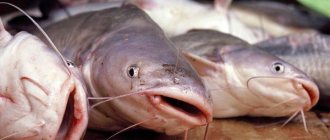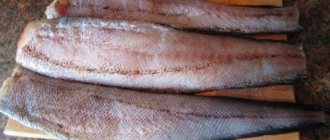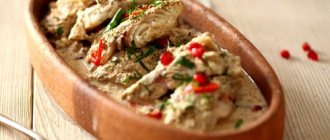Dried fish - calorie content, beneficial properties, benefits and harms, description
Calories, kcal:
139
Carbohydrates, g:
0.0
Drying is the cold drying of a product, resulting in dehydration of the product at a temperature not exceeding 40 degrees.
In relation to fish, it is known that in dry, windy weather, the raw material is dried in a couple of days (calorizer). However, depending on climatic conditions and the size of the fish, the duration of drying may exceed two weeks.
You can dry fish either whole (ram, roach, carp, shemaya, smelt), or its individual parts - the bellies and backs of salmon, sturgeon, and whitefish.
How to identify quality dried fish
Characteristics of quality dried fish: moisture content less than 38%, salt content less than 10%, clean scales, fatty meat.
To determine high-quality dried fish, you need to pay attention to the following indicators: intact scales, natural coloring, dry gills and abdomen, hard back.
To avoid infection with diphyllobothriasis, you should not purchase dried fish from random traders, giving preference to products made in a factory where the fish is subjected to shock freezing and carefully salted.
However, it is necessary to carefully select factory-produced fish that are not insured against spoilage.
The characteristic yellow color of the belly and the unpleasant odor indicate spoiled fish, the consumption of which is by no means safe due to the content of oxidation products, ketones and aldehydes, which are carcinogens.
Calorie content of dried fish
When talking about the calorie content of dried fish, you should consider the nutritional value of each fish. The calorie content of dried fish is 139 kcal per 100 grams of product.
Composition and beneficial properties of dried fish
Dried fish contains a significant amount of fluorine and phosphorus necessary for dental health (calorizator). Omega-3 polyunsaturated fatty acids, which are rich in fatty dried fish, help destroy cancer cells.
www.calorizator.ru
Taran
Do you know that:
Scientists from Oxford University conducted a series of studies in which they came to the conclusion that vegetarianism can be harmful to the human brain, as it leads to a decrease in its mass. Therefore, scientists recommend not completely excluding fish and meat from your diet.
Smiling just twice a day can lower your blood pressure and reduce the risk of heart attacks and strokes.
An educated person is less susceptible to brain diseases. Intellectual activity promotes the formation of additional tissue that compensates for the disease.
There are very interesting medical syndromes, for example, compulsive swallowing of objects. One patient suffering from this mania had 2,500 foreign objects in her stomach.
Tooth decay is the most common infectious disease in the world, which even the flu cannot compete with.
Regular use of a solarium increases your chance of developing skin cancer by 60%.
It was previously believed that yawning enriches the body with oxygen. However, this opinion has been refuted. Scientists have proven that yawning cools the brain and improves its performance.
When lovers kiss, each of them loses 6.4 calories per minute, but at the same time they exchange almost 300 types of different bacteria.
American scientists conducted experiments on mice and came to the conclusion that watermelon juice prevents the development of vascular atherosclerosis. One group of mice drank plain water, and the second group drank watermelon juice. As a result, the vessels of the second group were free of cholesterol plaques.
During operation, our brain expends an amount of energy equal to a 10-watt light bulb. So the image of a light bulb above your head at the moment an interesting thought arises is not so far from the truth.
The average life expectancy of left-handers is shorter than that of right-handers.
The human stomach copes well with foreign objects without medical intervention. It is known that gastric juice can even dissolve coins.
The well-known drug Viagra was originally developed for the treatment of arterial hypertension.
A job that a person doesn’t like is much more harmful to his psyche than no job at all.
The rarest disease is Kuru disease. Only members of the For tribe in New Guinea suffer from it. The patient dies of laughter. The disease is believed to be caused by eating human brains.
Dried fish - calorie content, beneficial properties, benefits and harms, description
Calories, kcal:
275
Carbohydrates, g:
3.3
Dried fish is a favorite and traditional snack for beer in our country. In other countries, dried fish is not as popular and other snacks are preferred. For example, Israelis snack on beer with chicken, and Belgians snack on salted cheese. In the UK they eat fish and chips with a foamy drink, in the USA they eat pizza, shrimp and lobster, in Germany they serve sausages, tongue, ham, nuts and cheese (calorizator). In France, they eat pate and shellfish with beer, but it is almost impossible to find dried fish.
Calorie content of dried fish
The calorie content of dried fish is influenced by the type of original raw material and drying methods. On average, calorie content is 275 kcal per 100 grams of product.
Composition and beneficial properties of dried fish
Dried fish contains a large amount of calcium, in particular small fish, which are usually eaten with bones. This product is also enriched with a large amount of phosphorus and fluorine, which is undoubtedly valuable for the human body. Doctors often advise cancer patients to use dried fish as an aid. Since polyunsaturated fatty acids (omega-3), contained in fatty varieties of dried fish, help destroy cancer cells.
Dried fish in cooking
Nowadays, an assortment of dried fish is presented in abundance on the Russian food market, and this product is easy to prepare yourself.
There are two main methods of drying fish, which make it possible to divide this product into the following types: fish made by hot and cold methods. In the first method, the fish is dried at temperatures above 200 degrees. The disadvantage of this method is that the final product - dried fish - almost does not retain the beneficial substances that were present in the original product (calorizer). When using the cold method, fish is dried under artificial or natural conditions at a temperature not exceeding 40 degrees. The advantage of the method is that dried fish better preserves the original beneficial properties of the original product.
There is also a division of dried fish into salted-dried and fresh-dried. This division into types makes it clear that fish can be dried, either by salting it or not.
Contraindications for use
It is not advisable to purchase dried fish from your hands, as you can harm yourself, namely, become infected with an intestinal disease - diphyllobothriasis. In production, fish is quickly frozen or well-salted, which provides a practically safe dried product.
www.calorizator.ru
How many calories are in boiled, fried, baked fish?
During the cooking process, you can reduce the calorie content. For example, when baking or cooking fatty varieties of sea and river inhabitants, their energy value decreases. For therapeutic and dietary nutrition, gentle heat treatment methods are used:
- Steam. Nutritionists advise using this method, because with this processing of the product all the beneficial substances in the fish remain. The absence of oil and waste fat promotes weight loss and has a good effect on the body of people with problems with the gastrointestinal tract. 100 grams of, for example, steamed salmon contains 101 kcal.
- Baking in foil. The calorie content of a product prepared in this way is higher than that prepared under the influence of steam. The energy value of red fish baked in foil is 197 kcal. And this steamed product contains 121 kcal.
- Grilling. Exposure to smoke and fire has a beneficial effect on the product. An open fire helps preserve the maximum amount of nutrients. Thanks to heat treatment, fish meat is tender and juicy. Calorie content increases slightly, but remains within acceptable limits. For example, steamed red fish has 121 kcal, and grilled steak has 155 kcal.
The worst option for preparing the product is frying. Substances released during the frying process negatively affect the heart, liver, and stomach.
Comparative table of calorie content of fried and boiled fish.
Calories in dried fish. Chemical composition and nutritional value.
Nutritional value and chemical composition of dried fish.
The table shows the nutritional content (calories, proteins, fats, carbohydrates, vitamins and minerals) per 100 grams of edible portion.
| Nutrient | Quantity | Norm** | % of the norm in 100 g | % of the norm in 100 kcal | 100% normal |
| Calorie content | 275 kcal | 1684 kcal | 16.3% | 5.9% | 612 g |
| Squirrels | 52.4 g | 76 g | 68.9% | 25.1% | 145 g |
| Fats | 5.8 g | 56 g | 10.4% | 3.8% | 966 g |
| Carbohydrates | 3.3 g | 219 g | 1.5% | 0.5% | 6636 g |
The energy value of dried fish is 275 kcal.
Primary Source: Created in the application by the user. Read more.
** This table shows the average levels of vitamins and minerals for an adult. If you want to know the norms taking into account your gender, age and other factors, then use the “My Healthy Diet” application.
health-diet.ru
Calorie content of dried fish. The benefits and harms of dried fish
By drying we mean a type of cold drying of products of organic origin, during which the dried material is dehydrated at temperatures up to 40 degrees. This temperature regime is lower than the thermal denaturation of the proteins of the feedstock under the influence of sunlight.
As a rule, in dry, windy weather, fish meat is well dried in just two to three days. But depending on the weather conditions and the size of the fish, the duration of drying can exceed two weeks. High-quality dried fish is characterized by a moisture content of less than 38%, clean scales, light salting (up to 10%) and fatty meat.
Drying is most typical for the following types of fish: ram and roach (often in common parlance these words are used in relation to dried fish in general), carp, shemai, vimba, as well as Asian smelt. It is customary to use drying to prepare the belly parts (teshi) and back parts (balyki) of salmon fish (nelma and white fish), sturgeon fish (stellate sturgeon and sturgeon), and whitefish (muksun and omul).
Signs of high-quality dried fish include such indicators as intact scales, natural color, dry belly and gills, and a firm back. The calorie content of dried fish directly depends on the nutritional value of each specific subspecies of waterfowl. When preparing dried fish dishes, meat that has been pre-soaked in salted water is used. Typically, dried fish meat is stewed or boiled.
The benefits of dried fish
Small fish, which are often eaten dried or dried with bones, are a rich source of calcium. Moreover, small specimens of fish not only have better taste, but also greater value: the benefits of dried fish lie in the content of phosphorus and fluorine, which protect our teeth from possible damage.
In addition, the benefits of dried fish as an assistant in the fight against cancer are known. The fact is that, according to research by scientists from Norway, omega-3 polyunsaturated fatty acids, which are present in fatty types of dried fish and fish oil, can destroy cancer cells.
Harm of dried fish
Meanwhile, damage to dried fish is possible when purchasing this valuable product from your hands - it is likely that you become infected with an intestinal disease - diphyllobothriasis. Only in production are absolutely safe dried products produced, since it is there that the fish undergoes a very important stage of preparation - shock freezing or thoroughly salted.
However, even factory-dried fish is not immune from spoilage. For example, if its belly has turned yellow and the fish has an unpleasant odor, then they are offering you a spoiled product. It is no longer possible to consume such dried fish due to oxidation products, ketones and aldehydes, which are carcinogenic substances.
food-list.ru
Calorie content of fish snacks, straws and salted dried fish
Proper nutrition is one of the components of health, but you should not approach it too radically. Chips, fast food, beer are, of course, harmful, but how sometimes you want to “harm” yourself! Even if you can’t, even if you’re on a diet, even if your figure will suffer and there’s a panicky fear of adding a few millimeters to your waist.
A Champions League match, a game of your favorite club, or just a good movie with friends - how can you not drink a bottle or three of beer while doing this? And what could be a better snack for beer than dried salted fish?
The calorie content of this product is a parameter that only a few know. Everyone thinks that there is no benefit from it, but how “useless” it is - what difference does it really make? Let's look at how many calories everyone's favorite salted dried fish contains, and will it do much harm if “a little bit”?
How many calories are in salted dried fish?
No matter how much one would like to operate only with exact numbers and data, this is simply impossible.
All fish are different, and their calorie content, accordingly, is also different. If we take the average value, then the calorie content of salted dried fish is 275 kC per 100 grams of product . A lot of? If you like sandwiches with butter, then for you this figure is a drop in the ocean, because 100 grams of butter contain 717 kC! Ordinary sunflower seeds are 584 kC for the same 100 grams.
But these are the most common foods that many eat regularly. If we consider the calorie content of salted dried fish of different types, the data will be approximately as follows:
These are the most popular and affordable types of salted dried fish, the calorie content of which may be of interest to many. As you can see, not a single species can even closely compare in caloric content with the same butter or sausage, which has an average of 300 kC per 100 grams.
You can if you are careful enough
Salted dried fish, the calorie content of which we have examined, usually serves as a snack for beer, which is clearly not the healthiest product. It follows from this that if you drink beer occasionally (the same Champions League matches do not take place every day), then you can eat fish without fear. Preservatives, low-quality spices and other additives that some manufacturers add can cause you much more harm.
Well, if you buy a high-quality product from those presented in our company’s catalog, then you won’t have to worry about calorie content and safety at all!
unionfish.ru
Calorie content Dried fish (Fish and seafood). Chemical composition and nutritional value.
Nutritional value and chemical composition of “Dried fish (Fish and seafood)”.
The table shows the nutritional content (calories, proteins, fats, carbohydrates, vitamins and minerals) per 100 grams of edible portion.
| Nutrient | Quantity | Norm** | % of the norm in 100 g | % of the norm in 100 kcal | 100% normal |
| Calorie content | 139 kcal | 1684 kcal | 8.3% | 6% | 1212 g |
| Squirrels | 17.5 g | 76 g | 23% | 16.5% | 434 g |
| Fats | 4.6 g | 56 g | 8.2% | 5.9% | 1217 g |
The energy value of dried fish (Fish and seafood) is 139 kcal.
Main source: Internet. Read more.
** This table shows the average levels of vitamins and minerals for an adult. If you want to know the norms taking into account your gender, age and other factors, then use the “My Healthy Diet” application.
health-diet.ru
Diet features
Instead of sugar, you should use dried pineapple. Calorie content per 100 grams allows you to compensate for the lack of vitamins. The product can be included in various dishes that will acquire a wonderful aroma. Desserts are prepared from it, but added in moderation. You also need to consume it in moderation, for example, 100 g is already a large portion.
Usually the product is eaten in the first half of the day, but it is better not to do this in the evening. The beneficial properties of the fruit will be higher if a person exercises. Then bromelain works actively, which is necessary for the rapid breakdown of fat deposits. The substance will help eliminate cellulite in a short time.









